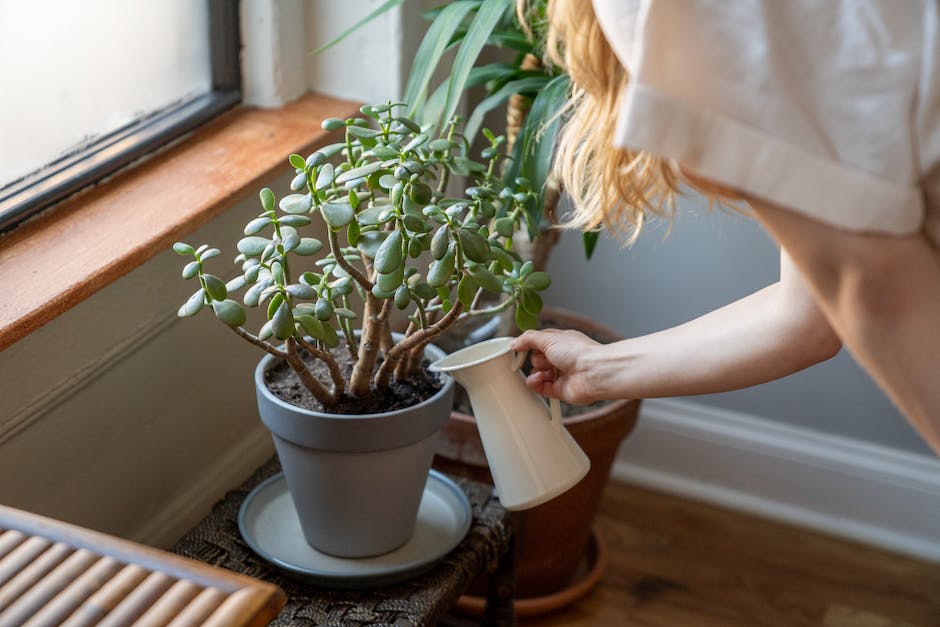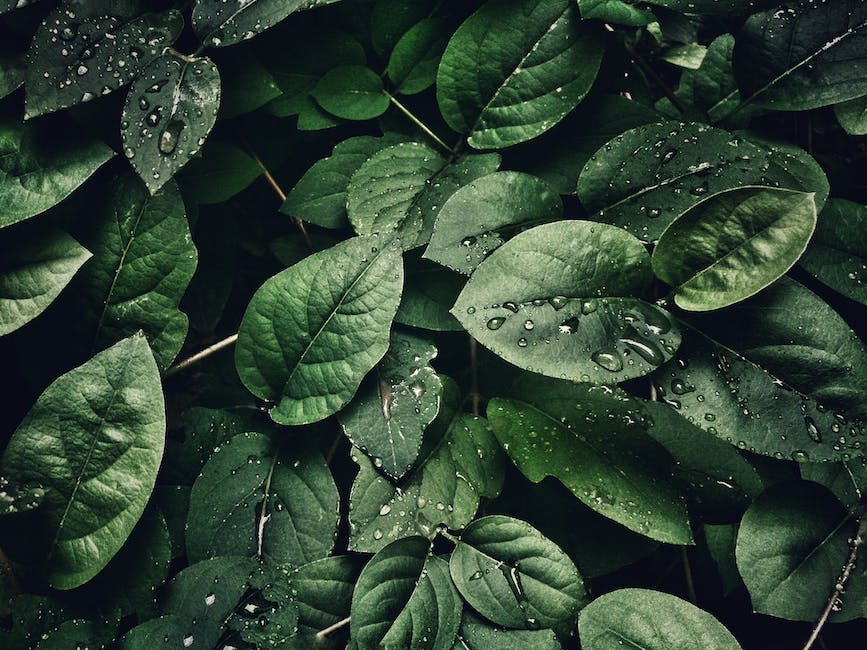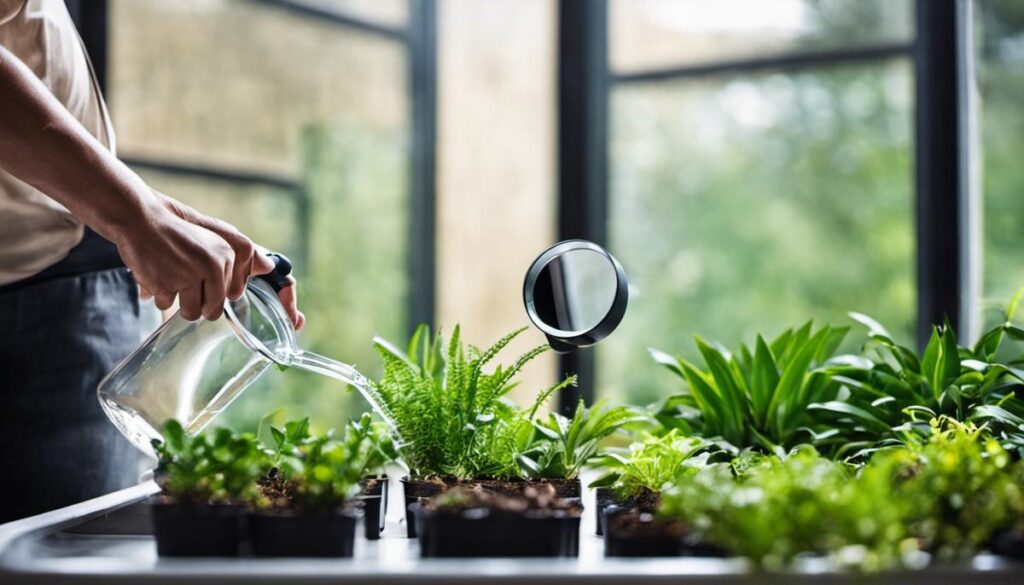In the world of indoor gardening, understanding the water requirements of your plants is paramount. Watering needs can vary greatly from one species to the next, affected by a myriad of factors such as the plant’s mechanism of photosynthesis, their transpirational activities, and the specific indoor environment they are situated in. For the novice or the busy indoor gardener, the realm of low-water indoor plants offers an appealing prospect.
These flora, characterized by features such as succulent leaves and thick bark, are well-adapted for water conservation, demanding less attention and care in terms of watering. An exploration into the world of these indoor plants can reveal a swath of available options for the indoor gardening enthusiast.
Understanding Plant Water Requirements

Understanding Plant Water Requirements
Water is crucial for all plants as it’s an essential factor in photosynthesis – the process by which they make their food. During photosynthesis, plants absorb carbon dioxide and sunlight to produce glucose (a type of sugar) and release oxygen. Some of this water is also used in transpiration, where it evaporates from the leaves and helps to transport nutrients from the roots to the rest of the plant.
The volume of water required by plants can vary greatly. Some plants are adapted to survive with little water, while others require a lot to thrive. Indoor plants, in particular, have different needs compared to their outdoor counterparts. This distinction is mainly due to factors such as the absence of rainwater, the control of temperature and humidity, and other environmental conditions indoors.
The indoor surroundings usually have lower light and humidity levels, which can impact a plant’s water requirements. A plant in a low-light situation will use less water than the same species grown under high-light conditions. Similarly, a plant in a highly humid environment will lose less water through transpiration compared to one in a low-humidity environment.
Indoor Plants that Require Little Water
Several indoor plants have adaptations that allow them to survive with minimal watering. These include succulent plants, such as cacti, which store water in their stems and leaves, and can survive for extended periods without watering. Similarly, snake plants, ZZ plants, and spider plants have thick, waxy leaves that reduce water loss, allowing them to thrive with less frequent watering.
The peace lily is another popular choice, which can survive with little water. Though this plant prefers moisture, it can also tolerate dry conditions. It’s a forgiving plant known to bounce back even if severely neglected. Another existent variety is the rubber plant, whose large shiny leaves retain water better than thinner leaves and therefore requires less frequent watering.
Understanding how to water houseplants correctly is essential. Overwatering is a sure way to kill indoor plants, as it causes the roots to suffocate and rot, making it impossible for the plant to take up necessary nutrients. It’s always safer to underwater your plants and increase watering gradually if the plant shows signs of needing more.
Understanding the Watering Needs of Indoor Plants
Even though many indoor plants can survive irregular watering, providing them with a consistent watering routine can ensure their robust health. The requirement of water may vary based on the specific plant species and the environmental conditions. Utilizing a water meter can make the task of watering indoor plants less daunting and more precise.
A popular method to determine the water needs of indoor plants is the ‘Finger Test’. This involves dipping your index finger into the soil up to your second knuckle. If the soil feels dry to the touch, it may be time to water your plant.
When watering your plants, ensure to hydrate the soil until water trickles out from the bottom of the pot. This guarantees that the root system of the plant receives adequate moisture. Also, take note that pots made from breathable materials like terra cotta tend to lose water faster. Thus, plants potted in these containers may need to be watered more often than those in plastic pots.
Lastly, be sure to revise your watering schedule in accordance to the seasons. Typically, indoor plants need less water during autumn and winter, as their growth rate decreases. On the other hand, they require more water during the spring and summer to support their phase of new growth.

Characteristics of Low-Water Indoor Plants

Identifying Indoor Plants That Need Limited Water
There are certain indoor plants that require minimal water. They often exhibit features that are inherently associated with survival in dry, harsh conditions. Thus, having evolved in such environments, these species possess inherent strategies to conserve water. This enables them to flourish even with limited watering. The distinctive adaptive traits of these plants have made them a popular choice among indoor gardening enthusiasts.
Succulent Leaves
One primary characteristic shared by most low-water indoor plants is succulent or fleshy leaves. Succulents like aloe, echeveria, and jade are popular indoor choices known for their thick, plump leaves. This characteristic is not just for aesthetic purposes but serves a crucial function in their survival strategy. The fleshy leaves are designed to store water, providing the plant with a kind of reservoir that it can tap into during periods of drought. By holding water within their leaves, succulent plants can endure long periods without watering, making them ideal for those without a green thumb or limited time for plant care.
Thick Bark or Waxy Surface
Another common characteristic among low-water indoor plants, particularly cacti, is their thick bark or skin. This outer layer helps the plant to conserve water by lowering the rate of evaporation. Moreover, some plants also have a waxy or glossy surface which helps retain water by limiting transpiration, which is the process by which water is carried through the plant from roots to small pores on the underside of the leaves, where it changes to vapor and is released to the atmosphere. Examples of such plants include ZZ plant, snake plant, and ponytail palm.
Shallow and Extensive Root Systems
Low-water indoor plants typically have shallow, but wide-ranging, root systems that allow them to absorb any available moisture efficiently. This adaptative feature also means they can do well in smaller pots and need less frequent repotting.
Sparse Foliage and Slow Growth Rate
Many low-water indoor plants have sparse foliage and grow slower than their thirstier counterparts. This is due to their strategy of conserving energy and resources in conditions where water is scarce. Slow growth rate and fewer leaves mean less water is utilized for photosynthesis and transpiration, allowing the plant to manage water usage more effectively.
Introduction
Adding plants to your indoor space can be more than just aesthetically pleasing; it is also beneficial for the environment. Low-water indoor plants are particularly suitable as they have unique adaptations to survive in water-scarce conditions and require minimal care. Not only do they make a splendid addition to any room, but they also offer a more sustainable choice. With a little insight into their nature and needs, both green thumb enthusiasts and beginners can successfully cultivate and take care of these plants.
Top Indoor Plants That Require Little Water

Getting to Know the Snake Plant: A Hardy Indoor Choice
First, let’s introduce you to one species that epitomizes low-maintenance indoor gardening: the Snake Plant. Also known as Sansevieria or the more amusing Mother-in-Law’s Tongue, this plant is resilient and requires minimal care. It does just fine in indirect sunlight or even low-light environments, perfect for spaces where sunlight is scarce. The Snake Plant isn’t too thirsty, needing water only once every 2 to 6 weeks, depending on the season. In fact, this plant would rather be a little bit on the dry side than be overwatered, as excessive water can lead to rot.
ZZ Plant: Compact and Glossy
The ZZ Plant, or Zamioculcas Zamiifolia, is appreciated for its waxy, green leaves that give it a sleek, modern aesthetic. This plant is extremely forgiving and can survive with watering as infrequently as once every 1 to 2 months. The ZZ Plant also tolerates low-light conditions but will grow faster in brighter indirect light. It prefers room temperatures and can be harmed by extreme cold.
Peace Lily: Elegant and Air-Cleansing
The Peace Lily is an excellent option for those seeking beauty and utility. Its glossy dark green leaves and charming white spathes add an elegant touch to any indoor space. While Peace Lilies do appreciate bright, indirect light, they can adapt to lower light conditions comfortably. They require watering only when the soil feels dry to the touch or when they begin to droop, usually once a week.
Pothos: Climbing Gem
Pothos, with its trailing, vine-like growth, is a popular indoor plant choice. It prefers indirect sunlight but can adapt to lower light levels. Despite its lush appearance, Pothos only requires watering every 1 to 2 weeks, or when the top inch of soil dries out.
Succulents: Variety and Versatility
There is a myriad of succulent types available, including the famous Aloe Vera and Jade Plants. All share a trait of water-storing leaves or stems, enabling them to survive periods of drought. Most succulents prefer bright light and will only need watering every 2 to 4 weeks, depending on light exposure and season. Overwatering is a common cause of succulent failure, as this can lead to root rot.
Cacti: Spiky Statement Makers
Much like succulents, Cacti store water in their bodies and require very infrequent watering. Depending on the species and its place of origin, some Cacti can survive watering only every couple of months. They can thrive in strong light conditions and are known to adapt to a wide range of temperatures.
In understanding the water and sunlight needs for indoor plants it’s crucial to be aware that these can differ considerably depending on elements such as humidity, pot or plant size, soil type as well as ambient temperature. Ensure that you monitor the health of your plant and adapt your care routine to satisfy its individual requirements.
House Plant Essentials
Caring for Low-Water Indoor Plants

Getting to Know Low-Water Indoor Plants
A wide range of plant species, commonly referred to as drought-tolerant or low-water indoor plants, originate from arid or semi-arid environments and have naturally evolved to thrive with little water. These resilient plants often possess unusual adaptations to help them store water and withstand extended dry periods. These categories of plants notably include succulents, cacti, and certain flowering or tropical plants. On being brought indoors, these plants are often preferred for their robustness and uncomplicated care regimen, making them an excellent choice for both gardening novices and those with packed schedules.
Optimal Watering Schedule
Proper watering is key to the well-being of low-water indoor plants. While these plants need less frequent watering, it’s important that they are watered thoroughly. It’s often recommended to water these plants once every 1-3 weeks and always allow the top inch of soil to dry out between waterings. However, it’s crucial to remember that watering needs can vary greatly depending on factors such as the type of plant, its size, and the environment, including temperature and humidity levels.
Signs of Overwatering
Often, many indoor plants are killed by overwatering rather than underwatering. Signs of overwatering usually manifest in the leaves and roots. The leaves may turn yellow or brown, wilt, or even fall off. Root rot, a disease that causes the roots to turn soft, mushy, and dark, is a common sign of too much water.
Best Soil and Pots for Low-Water Indoor Plants
When it comes to potting low-water indoor plants, good drainage is the absolute key. Choose pots with drainage holes and use a well-draining soil mix, often a cactus or succulent mix, that allows water to flow freely and prevent waterlogging. The pot’s material can also play a role in determining how well it holds or dissipates moisture. Terracotta, for example, is a porous material that allows both water and air to pass through its walls, keeping the soil dry and well aerated.
As for soil, a porous mix is ideal as it ensures surplus moisture doesn’t remain near the roots and cause decay. Sand, peat moss, perlite, or bark can be added to potting soil to enhance its drainage.
Adapting to Changing Seasons
Like other plants, low-water indoor plants also respond to changing seasons. They usually enter a dormant period during the cooler season when water requirements decrease further and active growth phase in warmer ones when there may be a slight increase in water need. Adapting watering patterns to these changes will keep the plants healthy and thriving.
Pest Management
Low-water plants are not immune to pests. However, their incidence might be lower, especially due to less humid conditions. Regular inspection and an adaptive pest management strategy are crucial to mitigate potential pest issues.
Transplanting and Pruning
Transplanting should be done sparingly since these plants prefer to be root-bound. Pruning for these plants mostly involves removing dead or decaying parts to mitigate potential disease and infection risks.
Remember, while low-water indoor plants are hardy and require less water, they still need care and attention to thrive. The right kind of pot, a suitable soil mix, adequate light, and balanced watering can ensure they grow healthy and beautiful.

Adopting a low-water indoor gardening approach is not only practical for the busy or novice gardener but also offers a unique aesthetic dimension to our living spaces. Just as each one of these plants has adapted to thrive with minimal water, through understanding and practising effective care techniques, such as the optimal watering schedule, spotting signs of overwatering, and selecting the appropriate type of soil and pots, we too can adapt our gardening practices. It is hoped that this introduction to the world of low-water indoor plants has offered some inspiration and guidance in embarking on or continuing your indoor gardening journey. After all, mastering the art of indoor gardening is not just about maintaining plants but is also about contributing positively to our environment and creating soothing spaces for ourselves.
